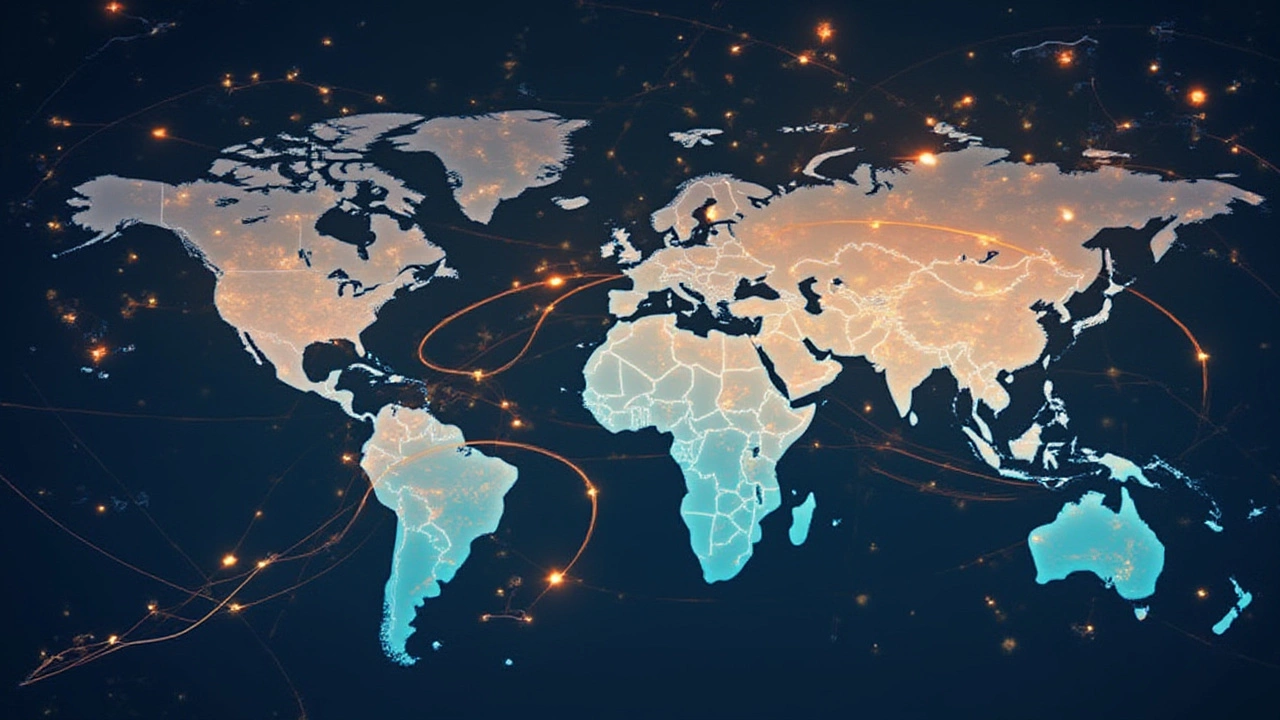There’s an empire quietly booming behind the scenes in India. It’s not Bollywood or textiles or even jewelry, but something far less glamorous—and far more essential. We’re talking chemicals. Hidden in tankers rolling down highways, packed into drums at ports, and fueling factories around the world, India’s chemical industry is a powerhouse. But what’s the real star? If you assumed the answer was generic—like fertilizers or paints—you’d miss the mark. The most exported chemical from India, surprisingly, is the mighty family of organic chemicals, especially those used for making medicines. Paracetamol, ibuprofen, acetic acid, dyes, solvents—the heart and soul of both the pharmaceutical and manufacturing worlds. This is the invisible engine moving not just India's economy, but global supply chains, especially as Western companies scramble to diversify away from China. Pull up a chair as we break down not only what makes these chemicals tick, but why India’s role matters so much in our everyday lives.
Organic Chemicals: India’s Power Player in Global Exports
Scroll through any major port in India—Mumbai, Mundra, or Chennai—and what you’ll see might surprise you. Containers marked with labels like “Acetic Acid,” “Paracetamol,” “Benzene,” and “Dyes.” Don’t be fooled by the scientific-sounding names—these aren’t just lab experiments. They’re the backbone of stuff that ends up on your pharmacy shelf or inside your smartphone. India’s rise here isn’t an accident. The country has honed its expertise over decades, focusing heavily on APIs, or Active Pharmaceutical Ingredients. These are the critical base materials behind most lifesaving medicines produced around the world.
India is the world’s third-largest producer of chemicals, and organic chemicals consistently top its export charts. The most notable category? Organic chemicals under HS Code 29. In the 2023-24 financial year, data from the Department of Commerce pinpoints this sector as leading with exports surpassing $24 billion USD. API exports alone bring in over $16 billion per year, with the bulk heading to the USA, Europe, and Southeast Asia. That’s not just trivia—it’s a sign that global pharma giants depend heavily on Indian chemical firms when making everything from aspirin to complex cancer drugs. It’s also why, every time a trade hiccup hits China, India becomes an even hotter chemical supplier.
While big brand names like Sun Pharmaceutical or Aarti Industries may get the limelight, the real legwork happens in a wild network of thousands of Indian firms scattered from Gujarat’s Vadodara district to Andhra Pradesh’s Vizag. Gujarat alone accounts for nearly 60% of India’s chemical output, thanks to its well-developed ports and special economic zones. Small and medium-sized manufacturers have mastered how to turn simple petrochemical feedstocks into specialized compounds. This “cluster advantage” gives India a massive edge, letting big buyers in Europe or America source large, consistent supplies at prices China often struggles to match. It’s no wonder multinationals now line up in Indian boardrooms, often signing multi-year purchase deals.
Let’s break down the favorite chemicals in the organic category. Paracetamol (acetaminophen), the go-to for fevers and headaches, is exported from India at levels exceeding 20,000 tons each year. States like Gujarat, Maharashtra, and Andhra Pradesh have massive plants churning out not just paracetamol but the solvents, acetates, and acids that keep other industries humming. Acetic acid alone accounts for exports worth over $900 million. Dyes, critical for the textile and auto industry, are another hidden hero—India exports reactive and azo dyes in bulk, shipping to more than 70 countries. There’s also a growing appetite for solvents such as ethyl acetate, used in paints, inks, and adhesives. All these add up to make organic chemicals the true export kings of India’s industrial landscape.
So, why does India do it so well? Two words: cost and skill. Wages are lower than in the West, but the real secret sauce is regulatory know-how. Indian firms, after years of exporting to strict markets like the European Union and US, have mastered tricky compliance rules. Intellectual property law, environmental licenses, safety standards—it’s all part of daily business here. That’s a level of credibility that newer players, even those in Vietnam or Turkey, struggle to duplicate (and buyers notice).

Why Organic Chemical Exports Matter (More Than You Think)
At first glance, bags of powder and vats of chemicals don’t seem like national treasures. But the ripple effects are everywhere. Let’s get real: pharma companies in London, Chicago, or Sydney are only as good as the APIs and solvents they get from their suppliers. If India’s chemical export engine stalls, you suddenly see global shortages and a spike in medicine prices. Remember the global COVID-19 scramble for hydroxychloroquine, paracetamol, and other critical drugs? India was at the epicenter, switching entire chemical production lines over to meet the world’s needs overnight. This critical role has only gotten stronger with geopolitics in play. As Western countries re-think overdependence on China, Indian chemical firms have become their go-to Plan B.
India doesn’t just export finished APIs and raw materials. It also ships intermediate compounds—think of these as the halfway products that other factories use to make final goods. These make up a $8.7 billion slice of India’s total chemical exports. From food preservatives to cleaning agents, these ingredients are loaded onto ships bound for over 25 major trading partners. The policy tailwinds are big too: government schemes like PLI (Production Linked Incentive) have made it easier for new chemical startups to set up shop, get access to cheaper financing, and ramp up capacity. There are now export hubs dotted across Maharashtra, Gujarat, and Tamil Nadu, each fighting for a bigger share of the global pie.
The technology factor also matters. Indian companies have invested billions in R&D and safety upgrades since the early 2010s—think cleaner reactors, leak-proof storage, and automated testing labs. This isn’t just for bragging rights. Multinationals demand these standards because a minor slip—an impurity here, a mix-up there—can halt product shipments or even lead to recalls. For API producers, these audits happen almost monthly, often Zoomed in live from Germany or the US. Indian managers are now pros at walking buyers through digital plants, showing real-time quality control dashboards, and ticking every compliance box. This is one of the main reasons why India is not only a volume leader but also a trusted supplier for ultra-high-quality goods.
Speaking of numbers, let’s lay out some recent stats in a table:
| Product | 2023-24 Export Value (USD Billion) | Top Destinations |
|---|---|---|
| Organic Chemicals (HS Code 29) | 24.1 | USA, China, Germany |
| Active Pharmaceutical Ingredients (APIs) | 16.2 | USA, UK, Netherlands |
| Acetic Acid | 0.92 | Indonesia, Brazil, UAE |
| Dyes and Pigments | 2.3 | Turkey, Bangladesh, Brazil |
| Solvents | 1.1 | USA, South Africa, Saudi Arabia |
There are also some little-known but very cool facts. Did you know that India exports the bulk of the world’s ibuprofen API? Or that global companies like BASF and Clariant have now set up research hubs in India to tap into local expertise? Another tip: if you’re investing, chemical export stocks like Deepak Nitrite, PI Industries, or Navin Fluorine tend to ride industry booms with solid double-digit annual returns.

Tips for Businesses and Individuals Tapping into India’s Chemical Export Scene
If there’s one thing the market has shown since the pandemic, it’s that chemical exports aren’t just resilient—they’re a goldmine if you understand how to play the game. For businesses looking to import from India, it pays to start with strong research. Always check if your supplier is certified under robust standards like ISO 9001, US FDA, or REACH; these badges mean the company won’t get your shipment seized for compliance violations. Due diligence is key. Ask for plant audit videos, check past export records, and don’t be shy about requesting references from big-name buyers. Indian exporters are usually more than willing to prove their mettle.
Customs can sometimes trip up new buyers. It helps if you work with an experienced logistics company, preferably one based near a major Indian export hub. Many of these firms offer end-to-end solutions, including real-time cargo tracking and regulatory paperwork. Customs duties can vary, so knowing your HS Codes (like 2915 for acetic acid or 2924 for paracetamol) can save you both time and money. Also, look out for seasonal price swings. Chemical prices can spike around Q2 and Q4 due to global demand cycles—if you need bulk imports, lock in contracts a month or two in advance to avoid surprises.
For those working in the start-up space, the government’s PLI scheme offers easier bank loans and faster environmental clearances if you produce pharmaceuticals and their chemicals for export. Several states also offer tax holidays and cheaper land to new manufacturers specialized in export-ready chemicals. Still, the biggest edge you can have? Technical talent and strong relationships. Indian universities churn out thousands of chemical engineers every year—snagging a young, creative team can help you out-innovate sluggish rivals. Try hosting research competitions or hackathons with a focus on chemical process optimization—you’ll attract skilled candidates and build your own mini R&D powerhouse.
The story goes beyond hard business, though. Everyday consumers benefit too. Think about it: every time you buy a generic drug at half the price, wear a color-fast t-shirt, or just grab packaged food with a longer shelf life, it’s likely that an Indian chemical was involved somewhere in its journey. The trust in Indian APIs by European and American regulators means safer, more affordable medicines in your cabinet. Even skeptics in global pharma circles admit it’s almost impossible to talk about resilient, affordable manufacturing without mentioning India’s chemical sector. The chemical export boom touches you, whether you notice or not.
So next time you spot a generic medicine bottle or buy a colored textile, remember: you’re holding the ripple effect of a massive export story. Organic chemicals aren’t just India’s top exported chemical—they’re the secret ingredient powering industries and changing lives worldwide. As for the future? With new factories opening and foreign companies lining up for Indian supply contracts, this is one export engine that shows no signs of cooling down.
